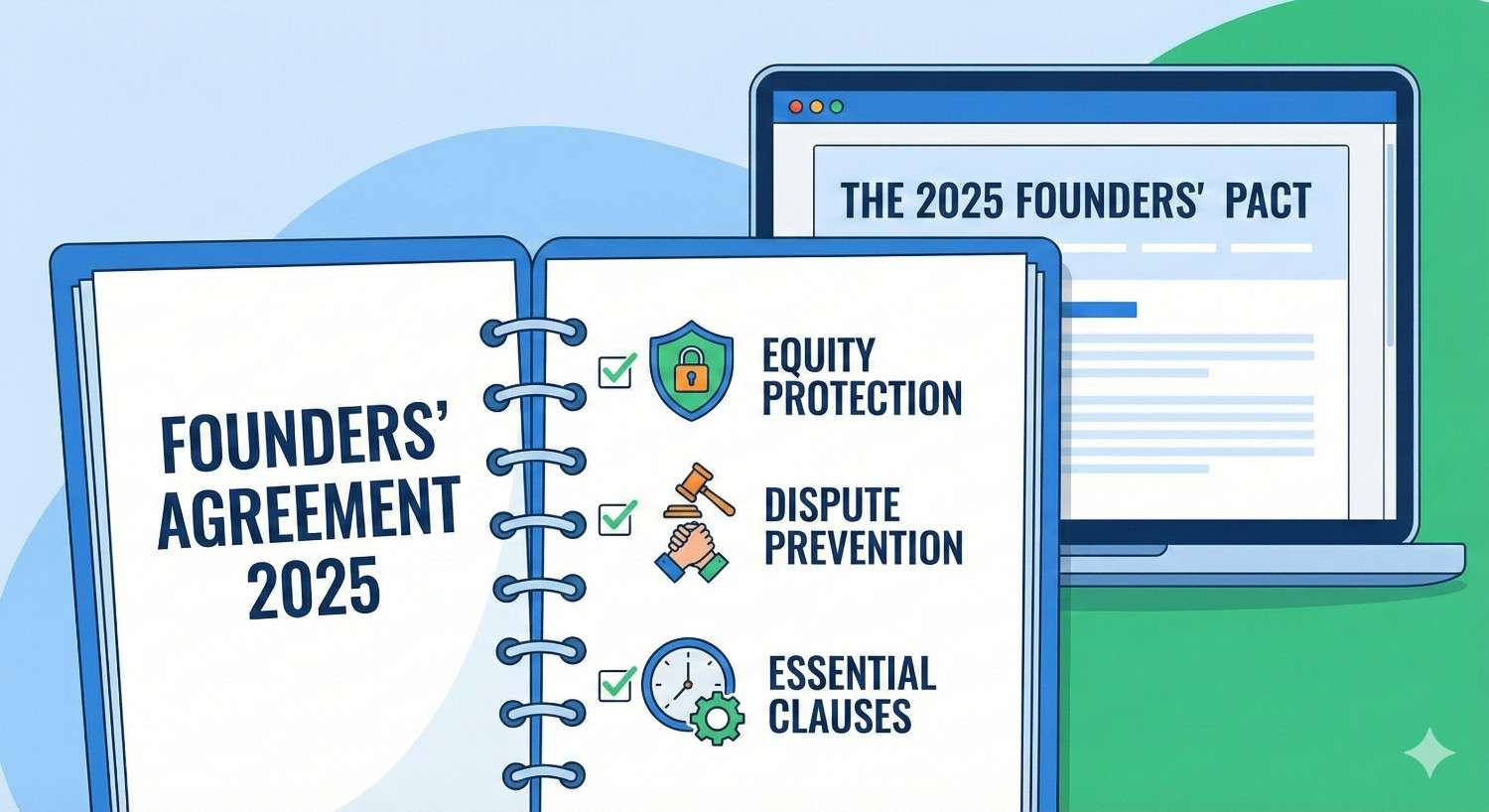TERM SHEETS & SHAREHOLDERS’ AGREEMENTS 2025: LEGAL CLAUSES INDIAN FOUNDERS OFTEN OVERLOOK
By SolvLegal Team

QUICK ANSWER
Many founders see term sheets and shareholders’ agreements as routine paperwork, but the real risks lie in the fine print. These early documents quietly shape how control and ownership play out in the final shareholders’ agreement. Clauses on anti-dilution, liquidation preference, board control, and exit rights often decide who truly runs the company after funding. Although term sheets are mostly non-binding, parts of them like confidentiality, exclusivity, and governing law can still have legal consequences.
This is only the surface. Every line in a term sheet has long-term implications for founders and investors alike. Keep reading to understand how courts interpret these clauses and what founders should never overlook before signing.
INTRODUCTION
In 2025, Indian startups are raising capital at a pace never seen before. Every week, founders across the country are signing term sheets that decide not just how much funding they get, but how much control they keep. With more than 1.4 lakh startups officially recognised by the Department for Promotion of Industry and Internal Trade (DPIIT) as of June 2024 and over 16.6 lakh jobs created through this ecosystem, the startup economy has grown too big to rely on handshake deals and blind trust. The documents you sign today will decide who truly runs your company tomorrow.
A term sheet often feels simple. Just a few pages with numbers, names, and investor details. But beneath that simplicity lies the foundation of your company’s future. It quietly defines how decisions will be made, who holds influence, and where your autonomy as a founder begins to narrow. Many founders treat it as a formality, assuming it carries no binding power. In reality, certain clauses like confidentiality, exclusivity, and good faith obligations can be legally enforceable under Indian law. Once it is signed, the direction of negotiation shifts, often in favour of the investor.
What follows is the Shareholders’ Agreement (SHA), the document that turns intent into commitment. It lays down how votes are counted, who sits on the board, how exits will happen, and how disputes will be resolved. Together, the term sheet and the SHA become the real constitution of your startup. The problem is that most founders rush through these documents, focusing on valuation instead of protection. In a market where deals move fast, overlooking a single clause can cost not just shares, but strategic control.
This article breaks down the legal provisions in term sheets and shareholders’ agreements that often go unnoticed. It explains how Indian courts view them, which clauses actually carry legal weight, and how smart drafting can protect your company from unnecessary risk. In today’s fast-paced startup ecosystem, legal clarity is not a luxury. It is a sort of a protection.
If you’re preparing to bring investors on board, explore SolvLegal’s Shareholders’ Agreement Templates Library, designed by legal professionals to help founders structure equity, control, and exit rights with clarity and confidence.
WHAT A TERM SHEET IS AND WHY IT MATTERS IN 2025?
A term sheet is often the first serious document that puts a startup’s funding conversation into writing. It lays out the core terms between a founder and an investor, including the amount to be invested, the percentage of ownership, and the rights attached to that investment. Though it usually runs only a few pages, it sets the structure for the entire deal that follows.
Many founders see a term sheet as an informal record of intent, something drafted before the lawyers begin the heavy work. That is only partly correct. A term sheet is the point where a business conversation starts to take legal shape. It sets out expectations, defines control, and gives both sides a preview of how decisions will be made once capital comes in.
Even though most term sheets are called non-binding, they are not entirely without legal effect. Clauses dealing with confidentiality, exclusivity, and governing law are often enforceable. If breached, they can lead to real legal disputes even before the investment agreement is signed. Many founders underestimate this stage, assuming that “non-binding” means “no consequence.” In truth, signing a term sheet marks the start of your legal responsibility, not just the beginning of the funding process.
By 2025, this early stage has become even more crucial. As India’s startup ecosystem expands and investors use more structured documentation, the term sheet now acts as a filter that decides how much control the founder keeps and how flexible the company remains for future fundraising. A loosely drafted clause today can easily turn into a binding problem tomorrow.
The smartest founders approach the term sheet like a foundation stone, reading it carefully, understanding every line, and negotiating where it matters. This is not about distrust; it is about foresight. Once you sign, you are not just raising funds, you are defining the legal framework that will guide your company’s next chapter.
Want a quick visual breakdown of what every founder should check before signing a term sheet? Read our post on LinkedIn where SolvLegal explains the must-have clauses every Indian startup should know.
INSIDE THE TERM SHEET: THE LEGAL CLAUSES INDIAN FOUNDERS OFTEN OVERLOOK
1. Anti-Dilution
Investors often add anti-dilution clauses to safeguard their ownership if the company raises funds in the future at a lower valuation. It sounds reasonable, but the way this protection is structured can have a major impact on how much of the company a founder continues to own.
There are generally two approaches. In one, the investor’s share price resets entirely to match the new, lower valuation. In the other, the adjustment is made proportionately, based on the amount of new capital and the revised price. The first can significantly reduce a founder’s stake overnight, while the second maintains a fairer balance between old and new shareholders.
Before you sign, it is essential to know which version applies, what triggers it, and how it will be calculated. These clauses should always be part of your company’s Articles of Association and not just buried inside the investor agreement. Only then will they hold up clearly and predictably if the company raises another round.
2. How Liquidation Preferences Affect Payouts
A liquidation preference decides who gets paid first when a company is sold, merged, or wound up. It is one of the most important clauses in any investment deal because it directly affects how the exit proceeds are distributed between investors and founders.
At its simplest, this clause ensures that investors recover their original investment before anyone else receives a payout. That sounds fair they took the early risk, after all. But the complexity lies in the details.
There are two main versions. The first is non-participating preference, where investors get back their invested amount, and the rest of the proceeds are divided among all shareholders. The second is participating preference, where investors first recover their capital and then also share in the remaining profits. While the latter may seem attractive for investors, it often leaves founders with a smaller share at exit.
For founders, it’s not just about what the clause says, but also how it defines “liquidation.” In some term sheets, liquidation includes internal events like buybacks or reorganisations, which can unintentionally trigger payout rights. The definition should be limited to genuine exit events such as mergers, acquisitions, or company sales.
When reviewing a liquidation preference clause, focus on proportionality and clarity. Ask how the return is calculated, whether there’s a cap on participation, and what exactly qualifies as a liquidation event. Founders who understand these details can negotiate protection without damaging investor confidence.
3. Drag-Along and Tag-Along Rights
Drag-along rights allow majority shareholders to require minority shareholders to sell their shares if a buyer wants to purchase the entire company. The intention is to make exits smoother and prevent smaller shareholders from blocking a deal that benefits most stakeholders.
In theory, this clause keeps everyone aligned when an acquisition opportunity arises. However, if drafted without balance, it can put founders at a disadvantage. Investors with drag-along rights can initiate a sale even when the founder may prefer to continue building the company or seek a better valuation.
The key is not to resist the concept but to shape it fairly. Founders should ensure that drag-along rights are triggered only in legitimate sale scenarios and at a reasonable valuation approved by both the board and the majority of shareholders. You can also request that the same terms apply to all shareholders, so everyone exits on identical pricing and conditions.
Another best practice is to link drag-along execution to a minimum return threshold or pre-agreed valuation floor. This ensures that the clause serves its intended purpose to enable smooth exits rather than being used as a tool to force premature sales.
When properly negotiated, drag-along rights create confidence among investors and founders alike. They demonstrate that while everyone is aligned toward eventual liquidity, no one party can unilaterally push others into an unfavourable exit.
4. Reserved Matters
Reserved matters are specific business decisions that cannot be taken without investor consent. They usually cover major actions such as raising new funds, altering the share structure, changing key management, or selling significant assets.
The intent behind these clauses is understandable investors want to protect their stake and ensure that strategic moves do not happen without their approval. However, when drafted too broadly, reserved matters can restrict founders from running the business efficiently.
Founders should review this list carefully. Operational decisions, like hiring staff, launching products, or marketing initiatives, should remain within management’s control. Investor consent should be required only for key structural or financial actions that genuinely affect ownership or risk.
A balanced reserved matters clause reflects mutual respect it reassures investors without undermining founders. When well-negotiated, it becomes a tool for accountability rather than control.
5. Founder Vesting and Equity Commitment
Founder vesting links share ownership to continued involvement in the company. It ensures that founders earn their equity over time, which protects both the business and the investors if someone leaves early.
This is now a standard feature in most Indian startup deals, and rightly so. It keeps co-founders committed and assures investors that leadership stability will continue.
The typical structure runs for four years with a one-year cliff. This means a founder must stay for at least a year before any shares are fully earned, after which vesting happens gradually. When negotiating, ensure that vested shares cannot be bought back at a discount if a founder exits on fair terms.
Vesting isn’t about mistrust; it’s about commitment. It gives founders a clear reason to stay invested in both time and spirit.
6. Founder Vesting and Equity Commitment
Founder vesting links share ownership to continued involvement in the company. It ensures that founders earn their equity over time, which protects both the business and the investors if someone leaves early.
This is now a standard feature in most Indian startup deals, and rightly so. It keeps co-founders committed and assures investors that leadership stability will continue.
The typical structure runs for four years with a one-year cliff. This means a founder must stay for at least a year before any shares are fully earned, after which vesting happens gradually. When negotiating, ensure that vested shares cannot be bought back at a discount if a founder exits on fair terms.
Vesting isn’t about mistrust, it’s about commitment. It gives founders a clear reason to stay invested in both time and spirit.
7. Exit Rights
Exit rights define how and when investors can sell their shares. These clauses matter because they determine how long capital stays locked in and how exits are managed.
Common exit routes include buybacks, IPOs, secondary sales, or acquisition-related exits. While investors need these provisions to realise returns, founders must ensure that exit triggers do not compromise the company’s growth timeline.
Before signing, check for obligations that allow investors to demand buybacks within short periods or at fixed valuations. Such clauses can pressure cash flow and restrict future funding rounds. A fair exit clause strikes a balance investors get clarity, and founders retain flexibility.
Good drafting can turn exit rights into a partnership tool rather than a point of conflict. They should reward success, not penalise growth.
STEPS FROM TERM SHEET TO SHAREHOLDERS’ AGREEMENT
Signing a term sheet is only the beginning. What follows is the real work turning a broad understanding into a binding legal structure. The term sheet captures intent, but the Shareholders’ Agreement (SHA) gives that intent a body. It is where every promise, protection, and right becomes enforceable.
In a funding transaction, the term sheet outlines “what both sides want.” The SHA records “what both sides must do.” Once executed, the SHA governs how the company will operate, how decisions will be made, and how ownership and control will be distributed. It also sets the framework for voting rights, share transfers, board structure, and dispute resolution.
However, one critical step is often missed aligning the SHA with the company’s Articles of Association (AoA). Under Indian law, that alignment is not optional. The Articles are the company’s rulebook and legally override any private contract. This position has been reinforced repeatedly by Indian courts.
In IL & FS Trust Co. Ltd. v. Birla Perucchini Ltd., 2004 (121) CompCas 335 (Bom), the Bombay High Court made this clear. At paragraph 6, the Court held that “the provisions in an agreement cannot be given effect to insofar as the management of the affairs of the company is concerned unless those provisions have been incorporated into the Articles of Association.” The Court also relied on the Supreme Court’s decision in V.B. Rangaraj v. V.B. Gopalakrishnan, reiterating that any restriction or right relating to shareholding is unenforceable unless it appears in the Articles.
The Articles bind all shareholders, present and future. The SHA, on the other hand, is a private contract between specific parties. When the two conflict, the Articles prevail. If your SHA promises an investor veto rights, drag-along rights, or pre-emptive rights that never make it into the Articles, those clauses are legally toothless. They may carry moral weight but will not survive in court.
This reasoning finds further resonance in the Supreme Court’s judgment in Tata Consultancy Services Ltd. v. Cyrus Investments Pvt. Ltd., Civil Appeal Nos. 440–441 of 2020, decided on 26 March 2021. At paragraph 16.25 of the judgment, the Court emphasised that even when majority shareholders act within their contractual rights, their actions must still respect the Articles and the broader principles of fairness and fiduciary duty. The Court noted that corporate democracy cannot be divorced from the obligations imposed by the company’s constitution.
For founders, the takeaway is practical. After signing the SHA, the next step must always be to amend the Articles of Association through a board and shareholder resolution to reflect every key clause especially those relating to share transfers, reserved matters, voting rights, and exits. This procedural step ensures that what is agreed privately can also be enforced publicly.
Think of the relationship this way:
1. The Term Sheet sets out the intention.
2. The Shareholders’ Agreement converts that intention into legal commitments.
3. The Articles of Association give those commitments statutory force.
When all three documents are consistent, the company’s governance is sound. When they are not, even the best-drafted investment agreement can collapse at the first sign of dispute.
HOW DO INDIAN COURTS TREAT TERMSHEET?
In India, courts have always treated term sheets and letters of intent with caution. They recognise that these documents often capture business intent, not binding legal promises. A term sheet becomes a contract only when the parties show a clear intention to create legal relations and agree on all essential terms.
This distinction between intent and enforceability has been drawn repeatedly in Indian jurisprudence.
The Supreme Court in Citibank N.A. v. Standard Chartered Bank, (2004) 1 SCC 12, explained that a document reflecting the course of negotiations or future intention cannot automatically be treated as a concluded contract. Though the Court dealt with interbank arrangements, it reaffirmed a broader contractual rule: no binding relationship exists until mutual assent is final and all essential terms are settled.
The Calcutta High Court had already clarified this principle decades earlier in Jyoti Brothers v. Shree Durga Mining Co., AIR 1956 Cal 280. The Court held that “a contract to enter into a contract is not considered to be a valid contract in law at all.” In other words, a letter of intent or term sheet that merely expresses future intention, without definite acceptance and consideration, cannot be enforced. This ruling directly supports the idea that most term sheets, unless very specific, remain non-binding.
Together, these judgments create a consistent legal position under Indian law:
1. A term sheet is not a contract unless all essential terms are agreed upon and there is a clear intention to be legally bound.
2. However, specific clauses within the term sheet typically confidentiality, exclusivity, or governing law can be enforceable if drafted with clear intention.
3. Even when not binding, a term sheet serves as evidence of the parties’ good faith and business intention, which courts may rely on to interpret conduct.
So, when founders or investors in India sign a term sheet, they are not just signing a “draft understanding.” They are signing a document that courts may read closely to infer how serious the parties were about the deal. The label “non-binding” is not enough what matters is what the parties did, said, and agreed to in writing.
A term sheet that’s vague remains an expression of interest. A term sheet that shows clear performance and defined intent can cross the line into enforceability. Indian courts have drawn that line carefully for over half a century and continue to do so in venture capital disputes today.
FAQS: TERM SHEETS AND SHAREHOLDERS’ AGREEMENTS IN INDIA
1. Are term sheets legally binding?
In most cases, no. A term sheet only records the intent to invest. However, clauses covering confidentiality, exclusivity, or governing law can carry binding force if written clearly.
2. What is the purpose of a term sheet?
It summarises the main commercial terms of an investment before detailed agreements are signed. It helps both founders and investors align on structure and expectations early in the process.
3. How is a term sheet different from a shareholders’ agreement?
A term sheet captures the understanding between the parties, while a shareholders’ agreement turns that understanding into a binding legal contract after due diligence and final approval.
4. Can founders negotiate a term sheet?
Absolutely. Every clause is negotiable at this stage from valuation and control rights to exit terms. Once it becomes part of the final agreements, revisions are much harder.
5. Why do investors insist on liquidation preference rights?
These rights ensure investors recover their capital first when a company is sold or dissolved. They reduce investment risk and bring clarity to how exit proceeds are distributed.
6. What are “reserved matters”?
They refer to major business actions that need investor consent such as raising new funds, changing the company’s share structure, or approving large borrowings.
7. Why should term sheet rights appear in the Articles of Association?
Because only provisions included in the Articles are enforceable against the company and its shareholders under Indian company law. It gives legal effect to what is agreed.
8. Which clause do founders often overlook?
Founder vesting. It links shareholding to continued involvement and ensures fairness if a co-founder leaves the company early.
9. Can a party back out after signing a term sheet?
Yes, unless the term sheet includes binding sections such as confidentiality or exclusivity. Breaching those clauses can still lead to legal consequences.
RELATED ARTICLE
1.Venture capital, governance and the fine line between support and control
2.Difference between trademark, copyright and patent (explained easily)
ABOUT THE AUTHOR
Aman Patel is a corporate lawyer focusing on company law, commercial agreements, and compliance strategy. He advises on contract drafting, business structuring, and legal due diligence for growing companies. A graduate of Symbiosis Law School, Hyderabad (B.A. LL.B.), he contributes his practical experience to SolvLegal’s legal resources for professionals and businesses.
https://www.linkedin.com/in/amanpatel-legal/
DISCLAIMER
The information provided in this article is for general educational purposes and does not constitute a legal advice. Readers are encouraged to seek professional counsel before acting on any information herein. SolvLegal and the author disclaim any liability arising from reliance on this content.






Leave a Comment